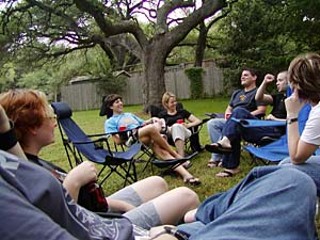A Tree Dies in Travis Heights
By Amy Smith, Fri., Sept. 5, 2003

When a work crew showed up the afternoon of Aug. 18 and uprooted a lovely, old live oak tree in Travis Heights, the neighbors looked on in anguish. One woman said it was like witnessing a murder. Another resident called City Hall to register her dismay. Another grabbed her camera.
The death of the tree was the culmination of a five-month struggle involving the neighborhood association, the property owner, the Board of Adjustment, and the city arborist, all of whom claimed to have the tree's best interest at heart. In the end, the dispute took its toll on a perfectly healthy oak that had for years graced a large corner lot on Kenwood Avenue. Arborist Jim Rhoades, who permitted the owner, Carolyn Barkley, to remove the live oak, placed the tree's age at between 100 and 200 years old.
"My heart just sank," Mark Schoppe said of his reaction when he arrived home from work to find heavy machinery eviscerating the tree in his yard. He and his partner had just renewed their lease with Barkley, who had the tree destroyed after being denied a variance by the Board of Adjustment on plans for a second rental home Barkley intends to build on the property. "I felt pretty sick about the whole thing," Schoppe said. "It was such an old, beautiful, and stately tree. People would just sit under it sometimes and read a book."
The trouble started when Barkley, who does not live in the neighborhood, sent a letter to residents asking for their support in her "plan to save the trees." The plan asked the neighbors to sign off on a proposed setback variance that would allow her to build the second unit 15 feet from the front property line, instead of the 25 feet required by city code. The variance, she said, would spare the oak tree. (Barkley had also sought to avoid building a sidewalk, as is normally required when an owner subdivides a property, arguing the sidewalk would require the elimination of two trees; that ultimately became a nonissue.) Until Barkley's letter, the neighbors were unaware that Barkley had even subdivided her property; city code (and state law) allows the Watershed Protection and Development Review Department to approve administratively such small-lot subdivisions without a public hearing before the Planning Commission or the usual notice to neighbors.
Leslie Belt and Jane Thurmond, who live across the street from the Barkley property, decided to investigate the matter further. Belt contacted the executive committee of the South River City Citizens neighborhood association to explain her concerns, while Thurmond obtained a copy of Barkley's building plan -- actually a rough outline of the home. Belt solicited the opinion of two architects in the neighborhood, who agreed that some creative, minor alterations to the design would give Barkley the home she wanted -- without the variance and without eliminating the tree.
Belt was further perplexed as to why Barkley would pitch her variance proposal as a tree-saving plan. "It seemed to us that she was asking us to help her save her trees from herself," she said. "It didn't make any sense."
At a Board of Adjustment hearing in April, SRCC advocated denying the variance. But Rhoades, the respected arborist for the city, informed the board in a letter that preserving the tree would be "tenuous or impossible" without the variance. Judging from an audiotape of the hearing, most of the board members appeared ready to grant Barkley the variance -- until Barkley's own developer agent, Mike McHone, volunteered that the house plan they were looking at was not the actual plan of the home Barkley intended to build. With nothing to go on but neighborhood opposition, the board voted 5-0 against the permit.
On Aug. 5, Barkley requested a permit to remove the tree and submitted another house plan to city staff -- this one for a two-story home with a two-car garage. Arborist Rhoades granted the permit but blamed his decision on the neighbors. "If the neighborhood opposition hadn't been so intense," he said, "the tree would still be there." Still, Rhoades acknowledged that he gets more than 100 requests like Barkley's every year, and that he issues more permits than he denies. He says a larger concern is the "thousands" of trees getting wiped out by big development and new subdivisions.
When contacted by the Chronicle, Barkley deferred to her attorney, Jim Nias, who also places blame on SRCC. "I live in the neighborhood, and I've driven by that tree hundreds of times," Nias said. "I wish there could have been some reasonableness." Nias said he was unaware that Barkley had since submitted a second plan for a house, part of which will cover the spot where the tree stood.
As for neighbor Belt, she believes there should be some sort of city appeals process for citizens to contest the arborist's decisions. "People in Travis Heights build around trees," she said. "That's what makes the property so valuable." Indeed, the tree issue gave Belt her first taste of the city "process," but she resents those who blame the neighborhood for killing the tree. "I thought that the ruling [of the BOA] would be taken into consideration, and that we as concerned neighbors could and should protect our neighborhood by following the process," she said. "We weren't fighting about development. We just didn't think [Barkley] should be given an unnecessary variance -- opening the gates for who knows what -- without a fight."
Got something to say on the subject? Send a letter to the editor.








